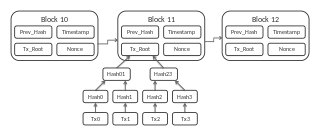The topic of this article may not meet Wikipedia's notability guidelines for products and services .(January 2018) (Learn how and when to remove this template message) |
| Feathercoin | |
|---|---|
 Official Feathercoin logo | |
| Denominations | |
| Plural | Feathercoins, FTCs |
| Symbol | FTC, ₣ (unofficially) |
| Demographics | |
| Date of introduction | 16 April 2013 |
| User(s) | International |
| Valuation | |
| Inflation | Limited release (geometric series, rate halves every 2.1 million blocks reaching a final total of 336 million FTCs) |
Feathercoin (FTC or ₣ [1] ) is an open source cryptocurrency, published under the license of MIT / X11.1, based on the Litecoin protocol. On 16 April 2013 Feathercoin successfully forked from Litecoin by the creation of its genesis block. As a cryptocurrency, creation and transfer of coins is based on an open source cryptographic protocol (the blockchain) and is not managed by any central authority.

A cryptocurrency is a digital asset designed to work as a medium of exchange that uses strong cryptography to secure financial transactions, control the creation of additional units, and verify the transfer of assets. Cryptocurrencies use decentralized control as opposed to centralized digital currency and central banking systems.
Litecoin is a peer-to-peer cryptocurrency and open-source software project released under the MIT/X11 license. Creation and transfer of coins is based on an open source cryptographic protocol and is not managed by any central authority. Litecoin was an early bitcoin spinoff or altcoin, starting in October 2011. In technical details, litecoin is nearly identical to Bitcoin.

A blockchain, originally block chain, is a growing list of records, called blocks, which are linked using cryptography. Each block contains a cryptographic hash of the previous block, a timestamp, and transaction data.
The hashing algorithm chosen for Feathercoin was the Proof-of-Work NeoScrypt, which had premiered on Phoenixcoin. NeoScrypt is 25% more memory intense, which makes it less feasible to create ASICs for it.
A Proof-of-Work (PoW) system is an economic measure to deter denial of service attacks and other service abuses such as spam on a network by requiring some work from the service requester, usually meaning processing time by a computer. The concept was invented by Cynthia Dwork and Moni Naor as presented in a 1993 journal article. The term "Proof of Work" or PoW was first coined and formalized in a 1999 paper by Markus Jakobsson and Ari Juels.
The main programmer is Peter Bushnell, at the time running the information technology for the Brasenose College of Oxford University. He explained his motivation for developing the coin in an interview with Vitalik Buterin. [2]
Information technology (IT) is the use of computers to store, retrieve, transmit, and manipulate data, or information, often in the context of a business or other enterprise. IT is considered to be a subset of information and communications technology (ICT). An information technology system is generally an information system, a communications system or, more specifically speaking, a computer system – including all hardware, software and peripheral equipment – operated by a limited group of users.

Vitaly Dmitriyevich "Vitalik" Buterin is a Russian-Canadian programmer and writer primarily known as a co-founder of Ethereum and as a co-founder of Bitcoin Magazine.
One month after launching Feathercoin, Peter Bushnell left his job as head of IT at the Brasenose College of Oxford University and lived off his Litecoin savings. [3]

Brasenose College (BNC), officially The King's Hall and College of Brasenose, is one of the constituent colleges of the University of Oxford in the United Kingdom. It was founded in 1509, with the library and chapel added in the mid-17th century and the new quadrangle in the late 19th and early 20th centuries.

The University of Oxford is a collegiate research university in Oxford, England. There is evidence of teaching as early as 1096, making it the oldest university in the English-speaking world and the world's second-oldest university in continuous operation. It grew rapidly from 1167 when Henry II banned English students from attending the University of Paris. After disputes between students and Oxford townsfolk in 1209, some academics fled north-east to Cambridge where they established what became the University of Cambridge. The two 'ancient universities' are frequently jointly called 'Oxbridge'. The history and influence of the University of Oxford has made it one of the most prestigious universities in the world.
He left the development of the coin in 2014 and returned to the platform in late December 2017 with the intention of bringing Feathercoin technically to the same level as Bitcoin Core 0.13 and subsequently adding Lightning and BarterDEX technology to the coin.[ citation needed ]

The Lightning Network is a "Layer 2" payment protocol that operates on top of a blockchain-based cryptocurrency. It enables fast transactions between participating nodes and has been touted as a solution to the Bitcoin scalability problem. It features a peer-to-peer system for making micropayments of cryptocurrency through a network of bidirectional payment channels without delegating custody of funds. Lightning Network implementation also simplifies atomic swaps.
On the 21st March 2018, the creation of the Feathercoin Development Foundation was announced. Its goal is to foster the development and acceptance of Feathercoin. Based in Zug, crypto-valley in Switzerland, the Feathercoin Foundation got rapid coverage by local media such as Swissinfo, [4] and Finews. [5]

Zug, is an affluent municipality and town in Switzerland. The name Zug originates from fishing vocabulary; in the Middle Ages it referred to the right to pull up fishing nets and hence to the right to fish.

SWI swissinfo.ch is a ten-language news and information platform produced by the Swiss Broadcasting Corporation. Its content is Swiss-centred, with top priority given to in-depth information on politics, the economy, the arts, science, education and direct democracy. Switzerland's international political, economic and cultural relations are other key points of focus. The website has ten language versions.